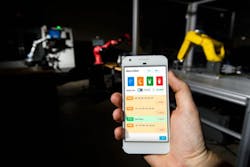There’s no shortage of robot news these days, from blending augmented reality with collaborative robots to an update on the use of robots in industry and the great robot safety debate. Last week at the Automate 2017 show, the industry witnessed another robotic innovation that has less to do with hardware and everything to do with cloud-based control.
Tend, a Boston-based startup, introduced its hardware-agnostic smart cloud robotics software that allows manufacturers to remotely control, monitor and analyze the performance of any robot from mobile devices. The software, called Tend in.control (intelligent control), allows users to securely interact with robots tending to production lines using a simple mobile interface. Dashboards provide a real-time view into the status of machines and specific jobs. And, if you need to stop or start a robot, that can be done remotely from any location via the smartphone.
Though some might shy away from cloud-based control for security reasons, there’s no need to worry with in.control—and here’s why. It uses basic USB cameras to allow robots to interface visually with machines without the need for networking or integration.
The robot-agnostic technology works without complex integration or software downloads, so there is no need to learn different systems or use a teach pendant on each robot. You can train and control all of your robots with a smart phone saving time and money. It also provides real-time visibility into OEE metrics, and can future-proof the factory as it scales quickly and will work to collect information related to the Industrial Internet of Things (IIoT).
“The one thing that all industrial machines have in common is that they were designed to interface visually with human beings,” said Mark Silliman, CEO of Tend. “So while we’re all looking forward to the day when machines can communicate more directly with one other, visual cues provide the best way for us to make those connections today, while creating a path forward to an IIoT reality.”
The system uses optical character recognition to take visual prompts as a way to perform quality inspections, check parts status or scan HMI screens for error messages, taking appropriate action to keep production moving. In addition, in.control enables the robot to automatically move between tasks without the need for reprogramming.
“It is a way to get meaningful data out of machines without integrating them to the network,” said Eric Foellmer, Tend’s chief marketing officer. “It’s all done in a visually-based way.”
Tend has been around for about a year and in.control is now available to manufacturers as a cloud-based managed service.
About the Author
Stephanie Neil
Editor-in-Chief, OEM Magazine

Leaders relevant to this article:
